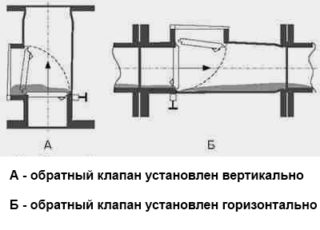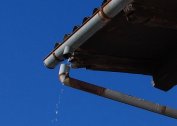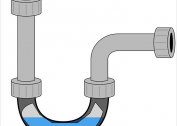In large multi-storey buildings, a very serious problem for residents is a blockage of the sewer riser, which leads to the discharge of all sewage through the first toilet or bathtub located above the blockage. Moreover, if a blockage occurred in the daytime, when residents actively use sewage systems, a large amount of effluents pouring through the toilet can seriously flood the apartment, lead to damage to the floor and furniture, increased humidity, and an unpleasant odor. A sewer shutter will help to avoid this situation.
Device definition and purpose
Sewer lock is a reliable and simple non-return valve used in sewer systems of high-rise buildings, cottages. Consists of the following parts:
- PVC case with top removable cover;
- bell with sealing rubber located on the side of the plumbing fixture to be connected;
- 1 or 2 round butterfly flaps located inside the housing and opening only in one direction;
- forced valve closing handle to lock the petals in the closed state.
The main functions of the shutter:
- Prevention of the reverse movement of sewage in sewer systems when blockages occur - the petals of the device, opening in one direction, easily pass sewage into the riser. With the formation of a blockage, the petals close and do not allow the drain from the upper floors to exit through the toilet, drain holes of the bathtub, sink, washbasin.
- Protection of premises from unpleasant odors of wastewater - the back sewer valve, closed most of the time, prevents their penetration.
- Preventing rats and other rodents from entering the apartment through sewer pipes - a valve flap that is closed in the absence of water flow blocks the way.
In cottages and private houses, such a lock contains a courtyard sewer, which avoids flooding of the bathroom, bathtub and living quarters with faecal and sewage water when the city collector is adjacent to it.
Principle of operation
The principle of operation of the most common two-chamber mechanical shutter in apartment buildings is as follows:
- In the absence of water current, two petals located one after another are in the closed position.
- When a flow appears, the flaps open under its pressure, closing after weakening.
- In the event of a blockage and reverse flow of wastewater from the riser to the apartment sewer, two lobes reliably block the path to the mass of water and prevent it from pouring out through the toilet or drain hole in the bathroom.
The great popularity of two-chamber sewer gates is explained by their reliability - even if 1 petal fails and allows water to pass through, a less worn and more reliable gate will prevent it from penetrating further.
Shutter Types
 Depending on the location relative to the floor level, non-return sewer valves are:
Depending on the location relative to the floor level, non-return sewer valves are:
- Horizontal - are parallel to the floor and connected to the riser at a right angle.
- Vertical - are installed directly in a vertical riser and are part of it.
Depending on the number of flap petals, there are:
- Single chamber shutter - equipped with one shutter. A typical representative of such devices is a simple dry shutter for sewage installed in a special drain ladder - a hole for discharging water in the concrete floor of basements and heating units of high-rise buildings. The gangway allows you to efficiently and quickly drain the flooded basements without the use of drainage pumps.
- Two-chamber mechanical or electric shutter - has two shutters located one after another. One of them can be fixed in the closed position using a handle or an electric drive.
 According to the type of actuator, these types of sewer check valves are distinguished:
According to the type of actuator, these types of sewer check valves are distinguished:
- Mechanical shutter - opening and closing the shutter occurs under the influence of water pressure.
- Electric drainage shutter - shutters open and close using a special electric actuator. This happens when 70% of the volume of the working chamber between the two shutters is filled with reverse water flow - while the sensor inside the chamber sends a signal to the control unit, which gives the actuator a command to close the shutters.
Criterias of choice
When choosing a reverse sewer valve, the following criteria should be considered:
- Terms of use - for in-house sewage, single-chamber inexpensive check sewer valves are suitable; for the basement, more expensive and high-quality models are used.
- Type of plumbing fixtures to be connected - for the kitchen sink, washbasin use valves with an internal diameter of 50 mm. The toilet and bathroom are connected to the riser by a sewer closure with an internal passage of 110 mm. A two-chamber non-return valve with an electric drive and an internal diameter of at least 160 mm is installed on the main pipeline and courtyard sewage system. In this case, the device is placed in a dry inspection well, which has a high, reliable head and a convenient hatch.
Mounting Features
The process of installing a horizontal sewer shutter using the example of connection to the toilet is as follows:
- The old pipe connecting the toilet to the riser is dismantled.
- A flexible corrugation is put on the toilet.
- The other end of the corrugation is inserted into the bell mouth.
- The return bell end of the shutter is inserted into the outlet of the cross on the riser.
- To seal the joints and simplify installation, they use a bell-shaped lubricant or plumbing silicone.
A shutter installed in this way will reliably protect the apartment from flooding by sewage.
The only drawback of such devices from the point of view of the layman is their tangible cost - a simple single-chamber mechanical shutter with an inner diameter of 110 mm costs about 2000 rubles. However, the one-time cost of buying a valve is much less than the cost of eliminating the consequences of flooding the apartment with drains, such as repairing or replacing floors, plywood wallpaper, or buying new plumbing.




